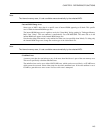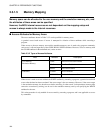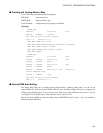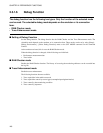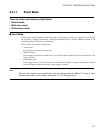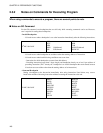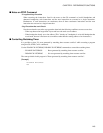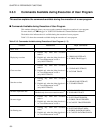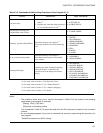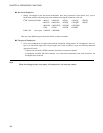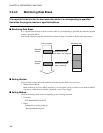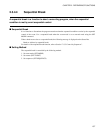
151
CHAPTER 2 DEPENDENCE FUNCTIONS
*1: For detail, refer to Section "2.3.6 Real-time Trace".
*2: For detail, refer to Section "2.3.1.6 Debug Function".
*3: For detail, refer to Section "2.2.1.4 Memory Mapping".
*4: For detail, refer to Section "2.3.4 Break".
Notes:
• The conditions which allow you to use the commands in Table 2.3-3 are limited to the following
cases when a user program is executed.
- [Debug] - [Run] - [Go] menu
- [Go] button on the debug toolbar
The commands in Table 2.3-3 cannot be used when the GO command is entered in the command
window.
• An error message appears if you enter a command that cannot be used during the execution of a
user program.
"E4404S Command error (MCU is busy)."
Set trace delay
1. Enabled only when trace execution
ended
*1
2. Enabled only when the debug function is
in "Trace Enhancement" mode.
*2
4.45 SET DELAY,
4.46 SHOW DELAY
Displaying execution cycle
measurement value (Timer)
- 4.27 SHOW TIMER
Memory operation (Read/Write)
Emulation memory only operable
*3
Read only enabled in real-time monitoring
area
5.1 EXAMINE,
5.2 ENTER,
5.3 SET MEMORY,
5.4 SHOW MEMORY,
5.5 SEARCH MEMORY,
5.8 COMPARE,
5.9 FILL,
5.10 MOVE,
5.11 DUMP
Line assembly, Disassembly
Emulation memory only enabled
*3
Real-time monitoring area, Disassembly
only enabled
6.1 ASSEMBLE
6.2 DISASSEMBLE
Breakpoint Settings
Oprable only when "Breakpoint Settings
during Execution" is enabled in the
execution tab of the debug environment
dialog.
3.1 SET BREAK,
3.6 CANCEL BREAK,
3.7 ENABLE BREAK,
3.8 DISABLE BREAK,
3.9 SET DATABREAK,
3.12 CANCEL DATABREAK,
3.13 ENABLE DATABREAK,
3.14 DISABLE DATABREAK
Table 2.3-3 Commands Available during Execution of User Program (2 / 2)
Function Restrictions Major Commands



